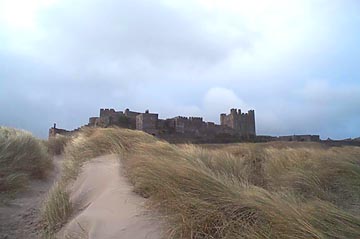

Bamburgh Castle in Northumberland is reputed to be Lancelot's fortress Joyous Guard. The castle Joyous Guard appears in the Vulgate Cycle (1215), where it is said to be in Northumberland. Sir Thomas Malory (1470) more specifically states that "some men say it was Alnwick, and some men say it was Bamborough". Bamburgh Castle today is an enormous fortress, on a rock separated from the sea by dunes and grasses.
Bamburgh Castle certainly existed as early as 547, a time that would allow an King Arthur connection. Before being called Bamburgh Castle, it had been called Din Guayrdi, one that quite easily suggests "Guard." However Malory's placing of Joyous Guard at Bamburgh Castle is not really substantiated.
One of the other many claimants for the title of Castle Joyeuse Garde is Elven in the Morbihan region of Brittany. This is doubtful as the oldest part of that castle dates from the tenth century. This castle is also famous as the prison of the future king of England Henry VII.
The castle in the King Arthur legend was originally known as Dolorous Guard and was owned by a wicked despot. Lancelot single-handedly took the castle and removed the wicked tenant.
However, in order to free the castle from a spell, Lancelot had to stay there for forty consecutive nights. Many adventures kept him away and his new subjects were not freed from the spell. Eventually Lancelot ,gained entrance via the castle chapel to a cave beneath the castle where he defeated a huge monster and gained the keys to unlock the enchantment. The gravestones that surrounded the castle magically disappeared and Lancelot to rename the place as Joyous Guard.
Sir Lancelot was continued to be an intermittent resident. Visitors included Sir Tristram and his lover, Isolde who lived here having had to flee the court of Isolde's husband, King Mark of Cornwall. However when Sir Tristram went off to take part in the Grail Quest, King Mark's armies took the castle and with it Isolde.
When Lancelot rescued his Queen Guinevere from being burnt at the stake, he took her back to Joyous Guard for safety. Later King Arthur besieged Joyous Guard and forced Sir Lancelot to flee to France. Apparently the castle's name then changed back to Dolorous Guard.
After his death in France, Lancelot's body was returned to Joyous Guard for burial.